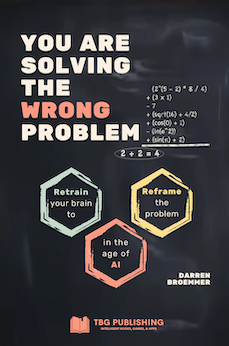From the book "You are Solving the Wrong Problem"Chapter 7: Reframing the Problem
Award-winning aeronautical engineer Paul MacCready, who was considered one of the best mechanical engineers during the 20th century, said it best.
"The problem is we don’t understand the problem." - Paul MacCready
Even individuals with exceptional skills can experience failure if they don't understand the problem. While AI can certainly be utilized to generate intriguing outcomes, it is unlikely to provide a definitive solution to the problem. Employing the wrong technique will not yield a satisfactory return on investment. Therefore, it is crucial to focus on working smarter rather than simply exerting more effort.
Reframing a problem statement is a strategic process. It is not an academic exercise, nor is it solely focused on wording. The important part is a shift in one's perspective. This shift helps you to uncover new insights and potential solutions.
No one said it would be easy though. Changing perspective is difficult. A popular saying in brainstorming is to think outside the box. This refers to new ideas or potential solutions that fall outside the conventional way of thinking.
The conventional way of thinking is a creation of our own minds. Our perspective is one that we created over time. We define the box in which we live.
It may not be easy to change our perspective, but we can do it. We will dive into this topic deeper when we discuss Cognitive Bias.
To illustrate the importance of perspective, we examine a particularly intriguing puzzle. This particular puzzle had me stumped for a while. I couldn't figure it out. It wasn't until I accidentally shifted the puzzle book in my hand that everything changed.
The puzzle is as follows. The figure below shows one square drawn within a grid of dots. There are 19 other squares that can be drawn from this grid, allowing for lines to cross through other dots. The challenge of the puzzle is to find the other 19 squares.
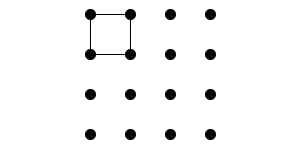
Everyone will easily find the first 14 squares. There are nine 1x1 squares, four 2x2 squares, and one 3x3 square. From here, the puzzle gets trickier. How can six other squares be formed from this grid?
See if you can solve the puzzle using a change of perspective. Consider what I shared about my experience of solving the puzzle.
If you get stuck, the figure below helps to provide a different perspective.
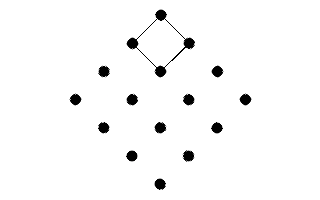
Note that an important aspect is the first square already drawn. It orients the reader towards a particular perspective. You initially find squares using that lens. Specifically, you find all the squares drawn using straight horizontal and vertical lines.
It isn't until the perspective is shifted that squares drawn using diagonal lines can be drawn within the grid. Some additional squares are shown in the figure below. From this, you can deduce the rest of the answer. There are four 1x1 diagonal squares and two 2x2 diagonal squares, for a total of 20 squares.
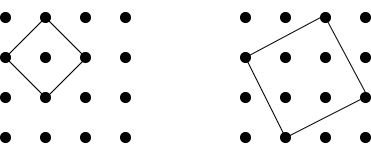
This puzzle may have seemed difficult at first, but the solution ended up being fairly simple. Rotate the grid by 45 degrees and the answer seems obvious. By comparison, earlier we saw how Tesla's business problem seemed difficult at first, yet the core business solution was based on the simple idea of meeting the customer where they are.
Once you ask your questions and gather data, you should have a solid understanding of the problem space. Your next step is to reframe the problem. You have reached the maximum width of the diamond fan-out shown in the figure below.
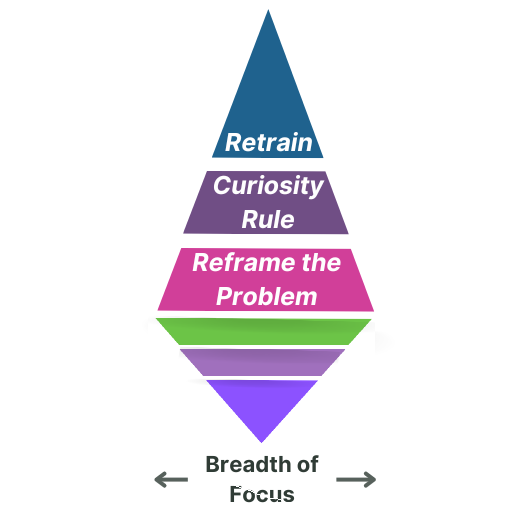
Consider the problem from the standpoint of different stakeholders or end-users. By empathizing with these diverse perspectives, you gain a more comprehensive understanding of the problem and its impact. This approach helps to break down any assumptions or biases embedded within the initial problem statement.
Another effective approach is to break down the problem into its smaller parts. This allows you to examine it from various angles and see what shift in perspective might be necessary. As you deconstruct the problem, identify the core issues and dependencies. Always be curious when doing this.
Ultimately, the art of reframing the problem is a dynamic process. It encourages creativity, flexibility, and a holistic understanding of the issues.
Deconstructing complexity
Smaller problems are simpler by nature. You have a better chance at success if you can convert a large problem into a smaller one. There are a number of ways to accomplish this. One method is to find a smaller version of the same problem.
A "smaller" version of a problem could be defined in several ways.
- It could involve smaller quantities.
- It might reduce the number of variables.
- Simplified models could be used to conduct experiments and gather data.
The idea of solving a smaller version of the problem is to gain insight. This may be the knowledge you acquire or a process that seems to work well. You may also be able to identify the root cause this way. It helps you find the right problem to solve.
Solving for the wrong variable
In an optimization problem, you are trying to maximize or minimize a certain variable. The variable could be cost, a feature of a product, or any number of things. The variable you are targeting may be a means to an end. In other words, you try to optimize one variable in order to help with another one.
Consider the design of an energy-efficient heating system for a residential building. Initially, you might focus on optimizing the heating equipment itself. You work to make sure the furnace (or heat pump) does its job efficiently. However, you may end up reframing the problem to target the optimization of the building's insulation and overall thermal performance.
Instead of solely concentrating on the efficiency of the heating equipment, your engineers might discover that significant energy losses occur due to poor insulation, inefficient windows, or thermal bridging in the building structure. By shifting the perspective, your team uncovers opportunities to improve the overall energy efficiency of the heating system by addressing the building itself.
This reframing approach still considers the initial variables, but it broadens the scope as well. The goal you really care about is the overall energy efficiency and sustainability of the building. Think of this as the abstract requirement. The decision to focus on equipment, the building, or some combination of the two is just your specific implementation of a solution for that requirement.
Symptoms as a facade
Imagine you wake up one morning with a pounding headache. You take a pain reliever, and the headache subsides. Problem solved, right? Not quite. The headache was merely a symptom of an underlying issue. Perhaps it was a lack of sleep, dehydration, or stress. If you only ever treat the headache, you're bound to encounter it again.
Symptoms can be red flags that alert us to the existence of other problems. They are visible manifestations of deeper issues, much like the way the visible tip of an iceberg is only a fraction of its true mass beneath the surface. Symptoms are often distressing, demanding immediate attention. Your job is to carefully consider whether they are the root cause or if there is something else to solve.
The design of lithium-ion batteries
Sticking with the theme of thermal management, the world of battery design faces similar, but somewhat opposite, problems. Lithium-ion batteries are essential components in smartphones and electric vehicles. As these batteries charge and discharge, they generate heat. If the heat is not properly managed, it can lead to safety risks, reduced battery lifespan, and performance degradation. For example, every time an electric vehicle drives uphill or accelerates rapidly, the dissipation of heat can become a problem.
Batteries are composed of a number of layers. The Anode is the negative electrode and the Cathode is the positive electrode. Separator layers act as insulators that prevent these two from shorting each other out. There are also Electrolyte layers that are comprised of a lithium salt in an organic solvent. These layers are typically stacked in a battery design. The layers do not manage heat very well when stacked flat on top of each other.
Researchers and product designers initially tackled this problem using complex solutions. They designed thermal management systems that used liquid cooling, phase-change materials, and cooling fins. These approaches suffered from numerous issues. Some were expensive. Others added unnecessary weight to the product. Some approaches experienced production issues because of the associated manufacturing complexity.
A cooling fin is a grooved aluminum plate that increases the surface area in the battery. It allows heat to dissipate faster. Researchers used this principle as the basis for an extremely simple solution: the "Swiss roll" battery design. Instead of stacking battery layers flat, they rolled them up into a cylindrical shape, like a Swiss roll cake. The design was extended to use a spiral, helix shape. There was more surface area, and cooling channels inside the cylinder provided extra airflow.

This simple solution achieved the goal and was easier to manufacture. Heat levels could be managed without adding significant complexity. It also had the added benefit of better space utilization. It was truly a remarkable design.
The solution to a "difficult" engineering problem was quite simple: Fold the battery layers into a circular roll. A straightforward, elegant solution had the potential to revolutionize battery technology. This design is used in the majority of cylindrical rechargeable batteries as well.
At the beginning of this design cycle, engineers came up with some great designs for the thermal management of batteries. However, the implementation of those designs revealed other complexities and challenges. This eventually led to a simplification of the design and a much better solution.
What is a well-framed problem?
You don't need a degree in literature to do this. The point is not to use fancy language or write a novel. Simple and direct language is actually better. The goal is to reframe the problem using a statement that is:
- Specific
- Measurable
- Focused on the root cause
The problem statement should clearly state what you are trying to achieve. You should be able to measure the degree of success. It should take a perspective that gives you an advantage.
The best way to understand these concepts is to go through an example.
Let's consider a case where the objective is to enhance the proactive and innovative nature of a company. A key approach to achieving this is through the implementation of an internal training program. The program consists of three levels: bronze, silver, and gold. Each level involves engaging in a hands-on project with the guidance of a mentor. The projects should not be purely academic but should yield tangible value for the organization.
Here are three possible problem statements:
- Our company does not get enough participation in the training program. Only 45% of junior and mid-level staff complete a bronze-level project.
- Our company does not have a culture of constant improvement and learning. Managers do not encourage participation enough.
- Each year, our company only completes 8 silver or gold-level training projects.
Which of these are good problem statements? Which are bad? How would you reframe the problem? Note that each statement uses fairly straightforward language. However, the perspective is different in each one.
Option one focuses on the junior and mid-level employees. Only 45% of them go into the training program and complete the first level (bronze). A reader of this problem statement would be inclined to focus on employee-level actions. Possible solutions might include an incentive program, or making a corporate change to have training added to everyone's annual goals.
- Strengths: Clearly identifies a specific metric (45% completion rate) and targets a particular group (junior and mid-level staff).
- Weaknesses: Lack of clarity on the desired target percentage and potential oversight of other organizational factors.
- Reframing: Reframe by specifying a more ambitious target completion rate for the bronze level, ensuring that it aligns with broader organizational goals. Consider exploring factors beyond individual incentives, such as the perceived value and relevance of the training projects.
Option two puts the focus on the overall company, as well as the managers. This option has a mixed perspective, or it can be viewed as managers presenting the corporate view to the employees. Solutions to this problem statement might include corporate programs to train and encourage managers to foster participation. Adding goals to all junior/mid-level employees might also be an option here.
- Strengths: Takes a holistic perspective on the company's culture and highlights the role of managers in fostering participation.
- Weaknesses: Vague in quantifying the extent of the issue and lacks specificity in proposing solutions.
- Reframing: Specify measurable indicators of a culture of continuous improvement, such as the frequency of knowledge-sharing sessions or the integration of learning goals into performance assessments. Consider a more targeted approach to manager training programs.
Option three focuses on higher levels of training. It is specific to the current metric, but it doesn't provide a goal.
- Strengths: Provides a specific metric (8 silver or gold-level projects) and focuses on higher training levels.
- Weaknesses: Lacks context, such as the total number of eligible staff and the overall organizational capacity for sustaining advanced projects. Does not provide a target metric.
- Reframing: Define a meaningful target for silver and gold-level projects based on a percentage of eligible staff or other relevant criteria. Consider assessing the feasibility and impact of each completed project to ensure they add significant value to the organization.
What would be a good number of completed training projects at each level? What percentage of staff does that represent, and what would the target percentage be? If everyone did a silver or bronze project, would there be enough worthwhile efforts that could be sustained by the company as a whole?
These are just some of the questions you could ask to flush out the problem. Apply the curiosity rule until you have enough information to reframe the problem. Use the three criteria (level of specificity, ability to measure, and focus on root cause) against each candidate statement.
Another observation would be that if the actual problem is a lack of innovation, you need to consider whether the internal training program is the right countermeasure. There may be other variables to optimize for.
Asking a "five whys" question
Go up a level and look at the bigger picture. Consider the following three problem statements.
- We don't innovate as fast as our competitors.
- We only launched one new product in the last two years.
- Declining revenue from our legacy products is not being replaced by new products.
How would you critique these three statements? How would you reframe the problem?
Option 1: We don't innovate as fast as our competitors.
- Strengths: Clearly identifies the issue of innovation speed in relation to competitors. Provides a comparative context for assessment.
- Weaknesses: Lacks specificity in terms of the nature of innovation or the competitors being compared. Does not quantify the current rate of innovation for benchmarking.
- Reframing: Specify the key areas of innovation that are falling behind, whether it's product features, technology adoption, or market strategies. Establish measurable benchmarks for innovation speed and identify specific competitors for more targeted comparisons.
Option 2: We only launched one new product in the last two years.
- Strengths: Highlights a tangible outcome (one new product) and a specific timeframe (last two years). Provides a clear baseline for measuring product launch frequency.
- Weaknesses: Does not delve into the reasons behind the low product launch rate. May not consider the complexity or development time required for certain types of products.
- Reframing: Investigate the factors contributing to the low product launch rate, such as R&D constraints, market research efficacy, or organizational processes. Establish realistic, yet ambitious targets for annual product launches based on the industry, market trends, and customer demands.
Option 3: Declining revenue from our legacy products is not being replaced by new products.
- Strengths: Identifies a critical issue, declining revenue from legacy products. Provides a basis for examining the impact of new products on revenue.
- Weaknesses: Does not specify the reasons behind the decline in revenue or the challenges in introducing new products. Lacks details on the types of new products considered and their potential market demand.
- Reframing: Investigate the root causes of revenue decline, such as changing customer needs, competitive pressures, or technological obsolescence. Develop a comprehensive strategy for introducing new products, considering market research, product differentiation, and effective marketing to ensure successful revenue replacement.
We have seen how we can retrain our brain and reframe the problem. This is the foundation of what we call the Diamond Pattern.
Chapters
2. Step out of Auto-Pilot Mode
3. Your most important skill: Asking Questions
4. Solve any problem using the Five Whys
5. AI Prompting like a Pro
6. Invention over Convention
7. How to Reframe a Problem to your Advantage
8. The Diamond Pattern: First fan-out, then fan-in
9. The Problem Paradox
10. Break free from Cognitive Bias
11. From Complex to Simple
13. Use AI for Data Analysis
14. The Curiosity Rule
15. Improve productivity by eliminating distractions
16. Optimization Problems
17. Greenfield or work within current constraints
18. Managing the most scarce resource: Time
19. Challenge yourself with Puzzles
20. Next Steps
21. Solutions to Puzzles

